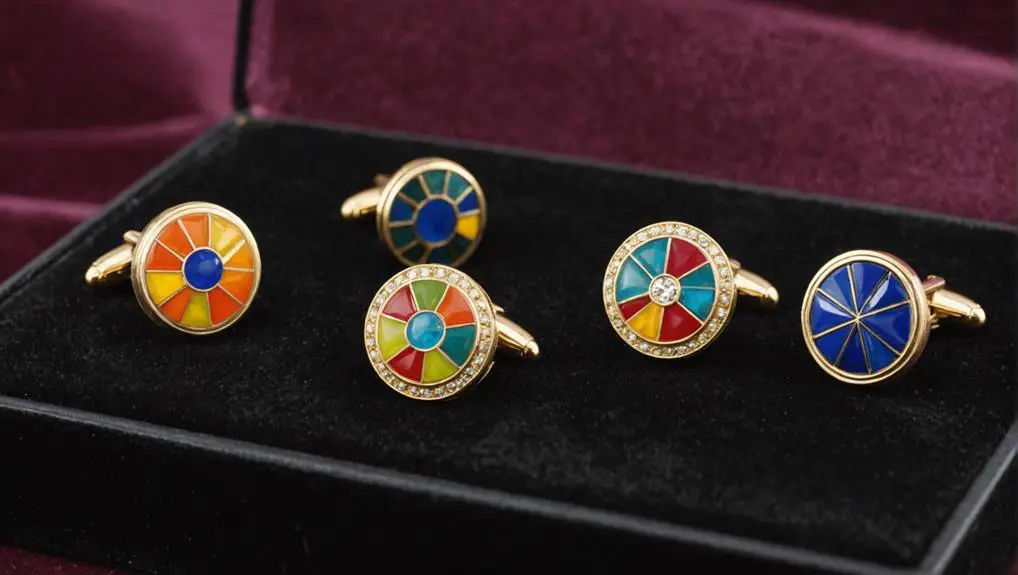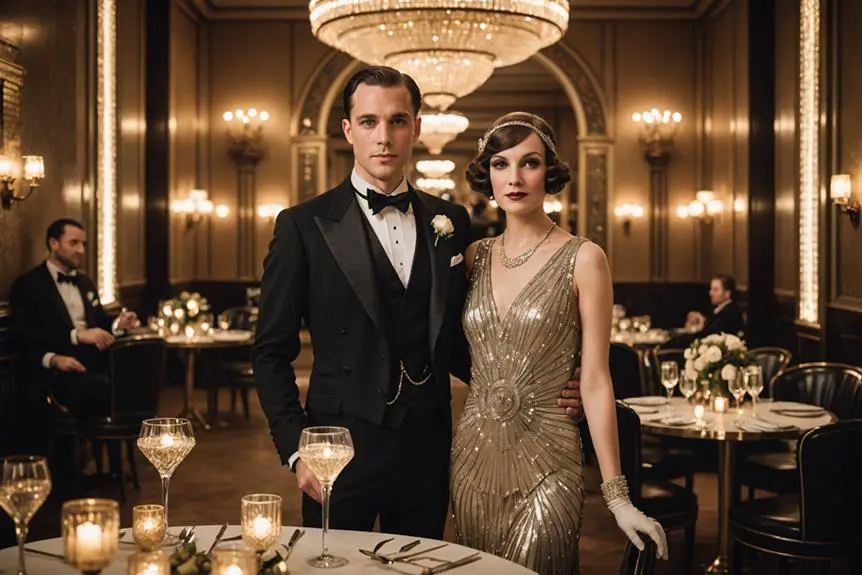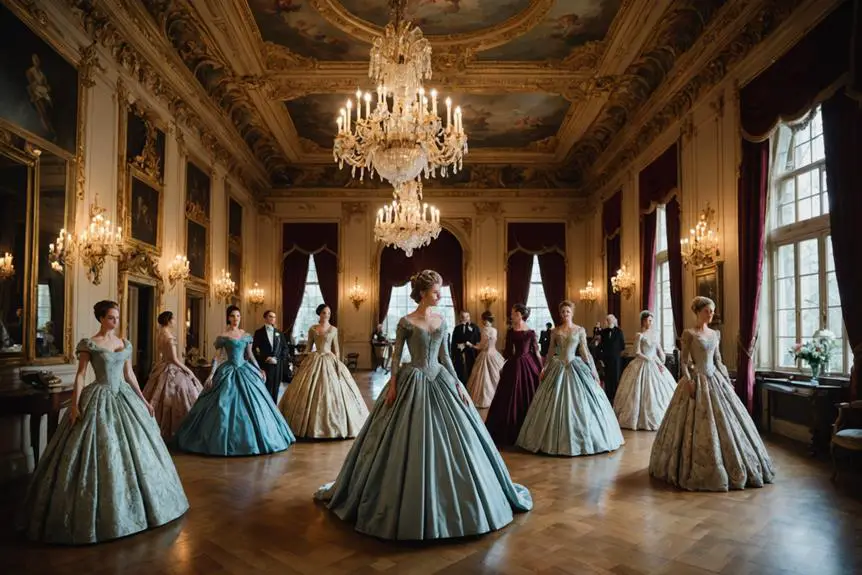Men's cufflinks in the 1960s were more than just accessories; they embodied a bold, creative spirit reflective of the era's fashion revolution. You'd find vibrant colors like turquoise and ruby set in intricate gold designs. Geometric shapes took over, with brands like Tiffany & Co. and Bulgari showcasing unique styles. Cufflinks often featured mixed materials, blending gold with gemstones or enamel for striking contrasts. Collectors today prize these vintage pieces for their craftsmanship and historical significance. Their appeal lies in not just aesthetics, but also the rich narratives they carry, hinting at broader cultural trends of the time. Explore more to discover iconic examples and what makes them so special.
Overview of 1960s Cufflinks
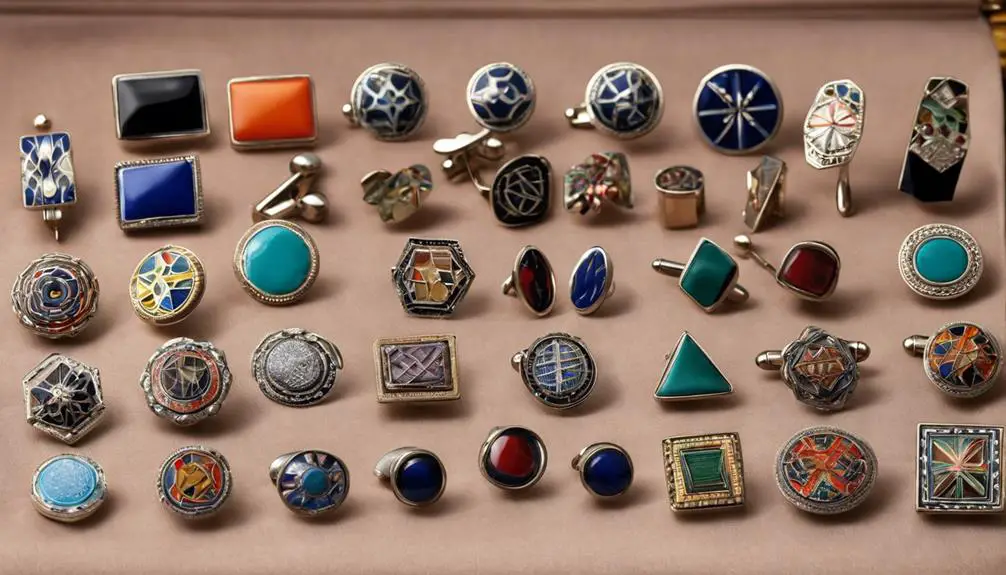
As the fashion landscape evolved in the 1960s, cufflinks emerged as a vibrant accessory that reflected the decade's bold aesthetic. You'll find that vintage gold cufflinks became particularly popular, often boasting striking designs and rich colors like turquoise and ruby. This era's Mid-Century designs featured unique shapes, from oval to square, capturing the attention of both fashion enthusiasts and collectors alike.
Notable brands such as Van Cleef & Arpels, Tiffany & Co., and Bulgari dominated the cufflink market, showcasing high-quality craftsmanship and innovative styles. Their pieces often displayed intricate motifs, including animal heads and sculptural elements, embodying the artistic trends of the time. The 1960s wasn't just about style—it was about making a statement.
Today, the demand for these vintage gold cufflinks remains strong among collectors, especially those that come with their original boxes. Such details not only enhance their collectibility but also increase their value. As you explore the world of 1960s cufflinks, you'll appreciate how they represent a fascinating blend of artistry and fashion, making them timeless pieces in any collection.
Key Materials and Designs
While exploring the key materials and designs of men's cufflinks in the 1960s, you'll discover a rich tapestry of luxury and innovation that defined the decade. Gold was a prominent material, with options ranging from 14k to 22k, often combined with silver or precious stones like turquoise and diamonds. These elements not only showcased craftsmanship but also reflected the era's opulence.
Design motifs during this time were diverse, featuring intricate patterns and geometric shapes that highlighted the artistry of renowned jewelers. You'd notice unique touches, such as animal heads or historical figures, further enhancing their appeal. Mixed materials became a trend, with cufflinks frequently blending gold with onyx or enamel, which created striking contrasts in texture and finish.
Notable brands like Tiffany & Co. and Bulgari led the charge, incorporating bright colors and luxurious materials into their designs, making their cufflinks highly coveted among collectors. Influenced by the mid-century modern aesthetic, cufflinks embraced streamlined shapes and minimalist styles that balanced elegance with the formal wear needs of the time. This blend of materials and designs truly encapsulated the spirit of the 1960s.
Popular Styles and Shapes
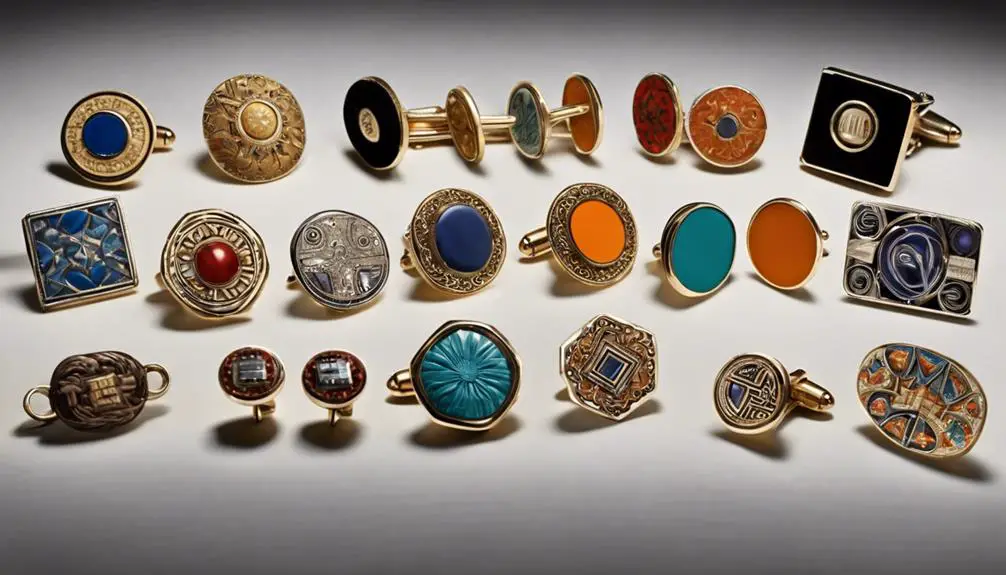
Cufflinks in the 1960s showcased a vibrant array of styles and shapes that mirrored the decade's cultural shifts and artistic movements. You'd notice that mens gold cufflinks became increasingly popular, often featuring unique shapes that reflected the era's bold aesthetic. The designs were not just about functionality; they were statements of style and sophistication.
Here are three popular styles that defined the decade:
- Geometric Shapes: Square and oval cufflinks dominated, characterized by clean lines and minimalistic designs that echoed the Mid-Century Modern influence.
- Sculptural Designs: Unique, artistic forms emerged, often showcasing intricate motifs like animal heads or historical figures, appealing to collectors and those with a taste for the unusual.
- Mixed Materials: Many cufflinks incorporated mens gold alongside materials like onyx and enamel, enhancing their visual appeal and craftsmanship.
These styles not only demonstrated the creativity of the time but also emphasized the luxurious materials used by brands like Tiffany & Co. and Bulgari, setting a standard for elegance in men's accessories. The 1960s cufflinks were truly a reflection of personal expression and artistic flair.
Notable Designers of the Era
During the vibrant 1960s, notable designers emerged, each bringing a unique vision to men's cufflinks that reflected the era's artistic evolution. Louis Feron captured attention with his elegant 18k gold designs, featuring striking lapis toggle links that exuded sophistication. Meanwhile, Salvador Dali, in collaboration with Piaget, introduced large cufflinks crafted in 22k and 18k gold, showcasing his surrealistic flair. These pieces were more than just accessories; they were wearable art.
Jean Schlumberger for Tiffany & Co. also made waves, creating cufflinks that combined vibrant turquoise and onyx. The interplay of colors against the backdrop of black brought a richness that stood out in formal attire. Larter & Sons became known for their geometric enamel cufflinks in gold, embodying the minimalist aesthetic of the time while emphasizing sleek lines and modernity.
Cartier, a French luxury brand, introduced iconic stirrup and halo styles, hallmarking their designs for authenticity. These cufflinks with black accents not only enhanced the appeal among collectors but also signified a luxurious approach to men's fashion. Each designer contributed to a dynamic landscape, making the 1960s a pivotal era for cufflink design.
Geographic Availability and Trends
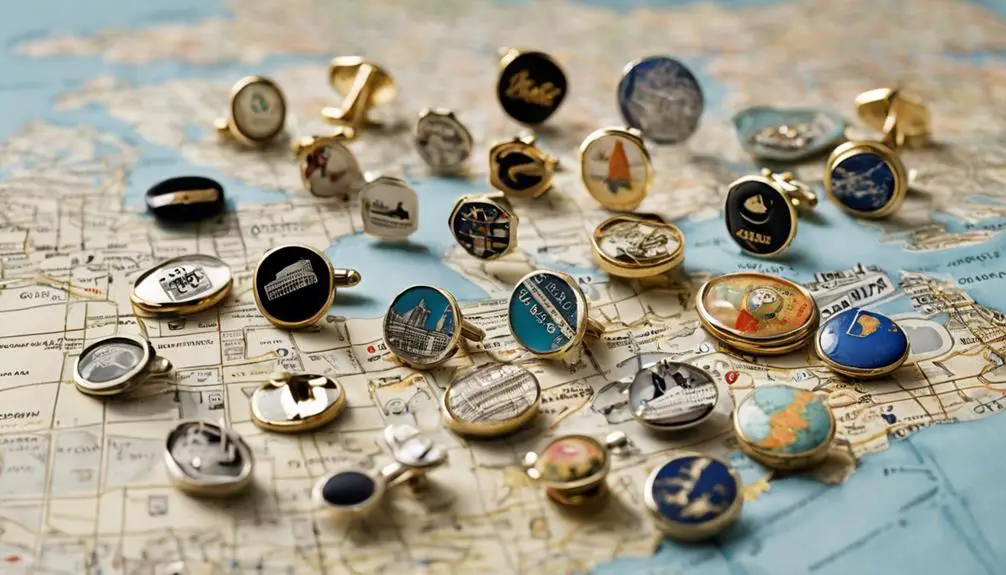
The vibrant scene of men's cufflinks in the 1960s extended beyond notable designers to encompass a rich geographic landscape that shaped availability and trends. Major cities like London, Las Vegas, and Miami Beach became hubs for unique cuff links, each reflecting local styles. You'd find a delightful mix of vintage designs that drew from Mid-Century Modern influences, characterized by geometric and minimalist aesthetics. Additionally, the evolution of cufflink styles mirrored the broader trends in vintage clothing, where identifying vintage characteristics played an essential role in appreciating these accessories.
Here are three key trends in geographic availability:
- City-Specific Styles: London offered classic elegance, while Las Vegas showcased bold, flashy designs, and Miami Beach embraced vibrant colors.
- Material Choices: Cuff links from this era often featured luxurious materials like gold, silver, and gemstones, appealing to both collectors and fashion enthusiasts.
- Emergence of Online Markets: Platforms like 1stDibs opened up global access to vintage cufflinks, enhancing availability and providing options for free shipping.
These trends not only highlighted the cuff links' role in formal wear but also encouraged a curated approach to accessorizing, making them integral to a man's ensemble during the decade.
Collectibility and Market Value
In the domain of men's fashion accessories, vintage cufflinks from the 1960s stand out as highly collectible items, thanks to their unique craftsmanship and the historical significance they embody. The allure of these cufflinks is amplified by renowned designers like Van Cleef & Arpels and Tiffany & Co., who crafted exquisite pieces that continue to captivate collectors today.
The market value of 1960s cufflinks can vary dramatically based on several factors, including material purity, condition, and provenance. For instance, oval cufflinks made from precious metals in excellent condition can command premium prices, especially if they retain their original packaging. Limited edition designs or unique styles enhance collectibility, often resulting in pairs selling for hundreds of dollars at auctions or vintage shops.
The resurgence in demand for vintage accessories, particularly those reflecting retro styles, has made these cufflinks a sought-after choice for formal occasions. As you explore the market, keep an eye out for pieces that showcase exceptional craftsmanship and notable designs, as these will not only elevate your personal style but also serve as valuable additions to your collection.
Iconic Cufflink Examples
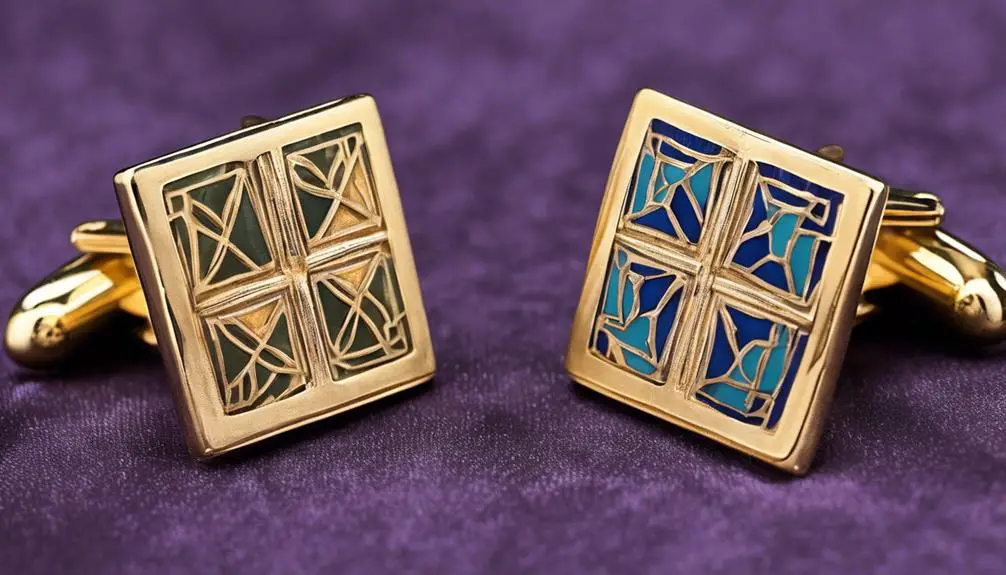
Exploring the world of 1960s cufflinks reveals a stunning array of designs that not only reflect the fashion trends of the time but also the artistic movements influencing them. One end of this fascinating spectrum includes luxurious materials like 14k and 18k gold, often adorned with intricate designs that captivated style enthusiasts. Here are three iconic examples that stand out:
- Tiffany & Co. Cufflinks: Featuring unique combinations of turquoise and onyx, these pieces became symbols of elegance and artistic flair.
- Hickok Mid-Century Cufflinks: The bold blue and gold patterns exemplify the era's mid-century design aesthetic, showcasing a vibrant color palette that was all the rage.
- Jean Schlumberger's Designs: Known for their sculptural elements and mixed materials, Schlumberger's cufflinks often reflected contemporary art movements, adding an avant-garde touch to formal attire.
These iconic cufflinks not only served a functional purpose but also made bold fashion statements, allowing men to express their individuality. Each piece tells a story of creativity and style, marking a significant era in men's fashion history.
Caring for Vintage Cufflinks
Maintaining vintage cufflinks requires a thoughtful approach to guarantee they remain in pristine condition for years to come. Start by gently cleaning them with a soft, lint-free cloth after each use. This simple step removes dirt and oils from your skin, preventing buildup that can tarnish their beauty.
Be cautious about exposing cufflinks to harsh chemicals or abrasive materials, especially those made of delicate materials like mother of pearl or gemstones. Such exposure can irreparably damage their surface or finish. When it comes time to store your cufflinks, consider keeping them in their original boxes or a padded jewelry case. This not only prevents scratches but also preserves the original packaging, which many collectors value highly.
For cufflinks with mixed materials, such as gold and enamel, avoid excessive moisture to protect the enamel from deterioration. Regularly inspect your vintage pieces for loose stones or damaged components, and don't hesitate to seek professional repair if needed. This proactive care helps to maintain their value and integrity, ensuring your cufflinks remain a cherished part of your collection for generations.
Frequently Asked Questions
When Did Men Stop Wearing Cufflinks?
You'll notice men gradually stopped wearing cufflinks in the 1970s, as casual styles gained popularity. By the 1980s, they became reserved for special occasions, marking a significant shift in everyday fashion preferences.
What Was the Original Purpose of Cufflinks?
Cufflinks originally served as functional fasteners for dress shirt cuffs, replacing buttons. They provided a secure closure while offering an opportunity to express individual style, evolving over centuries into both practical and decorative accessories in formal attire.
What Do Cufflinks Say About a Man?
Cufflinks reveal your personality and style. They showcase your attention to detail, creativity, or sophistication. Choosing unique designs or luxury brands signals your taste and status, making a lasting impression at any formal event.
When Did Buttons Replace Cufflinks?
Buttons began replacing cufflinks in the 1970s, as fashion shifted towards casual, practical styles. Tailored shirts with buttoned cuffs offered convenience, leading to cufflinks' decline in everyday wear and their association with formal occasions.
